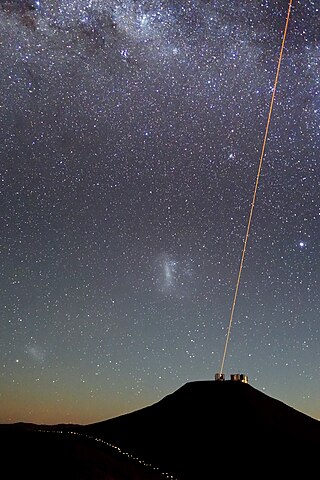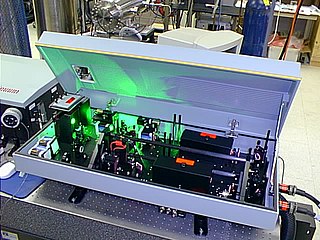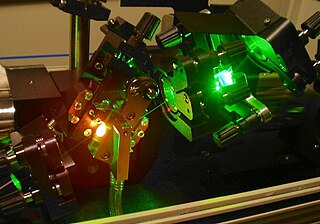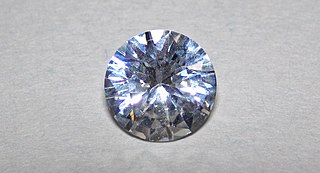Related Research Articles

A laser is a device that emits light through a process of optical amplification based on the stimulated emission of electromagnetic radiation. The word laser is an anacronym that originated as an acronym for light amplification by stimulated emission of radiation. The first laser was built in 1960 by Theodore Maiman at Hughes Research Laboratories, based on theoretical work by Charles H. Townes and Arthur Leonard Schawlow.

A laser is constructed from three principal parts:

Nonlinear optics (NLO) is the branch of optics that describes the behaviour of light in nonlinear media, that is, media in which the polarization density P responds non-linearly to the electric field E of the light. The non-linearity is typically observed only at very high light intensities (when the electric field of the light is >108 V/m and thus comparable to the atomic electric field of ~1011 V/m) such as those provided by lasers. Above the Schwinger limit, the vacuum itself is expected to become nonlinear. In nonlinear optics, the superposition principle no longer holds.

An optical amplifier is a device that amplifies an optical signal directly, without the need to first convert it to an electrical signal. An optical amplifier may be thought of as a laser without an optical cavity, or one in which feedback from the cavity is suppressed. Optical amplifiers are important in optical communication and laser physics. They are used as optical repeaters in the long distance fiberoptic cables which carry much of the world's telecommunication links.

In fiber-optic communications, wavelength-division multiplexing (WDM) is a technology which multiplexes a number of optical carrier signals onto a single optical fiber by using different wavelengths of laser light. This technique enables bidirectional communications over a single strand of fiber, also called wavelength-division duplexing, as well as multiplication of capacity.
All-silica fiber, or silica-silica fiber, is an optical fiber whose core and cladding are made of silica glass. The refractive index of the core glass is higher than that of the cladding. These fibers are typically step-index fibers. The cladding of an all-silica fiber should not be confused with the polymer overcoat of the fiber.
Mode locking is a technique in optics by which a laser can be made to produce pulses of light of extremely short duration, on the order of picoseconds (10−12 s) or femtoseconds (10−15 s). A laser operated in this way is sometimes referred to as a femtosecond laser, for example, in modern refractive surgery. The basis of the technique is to induce a fixed phase relationship between the longitudinal modes of the laser's resonant cavity. Constructive interference between these modes can cause the laser light to be produced as a train of pulses. The laser is then said to be "phase-locked" or "mode-locked".

Nd:YAG (neodymium-doped yttrium aluminum garnet; Nd:Y3Al5O12) is a crystal that is used as a lasing medium for solid-state lasers. The dopant, triply ionized neodymium, Nd(III), typically replaces a small fraction (1%) of the yttrium ions in the host crystal structure of the yttrium aluminum garnet (YAG), since the two ions are of similar size. It is the neodymium ion which provides the lasing activity in the crystal, in the same fashion as red chromium ion in ruby lasers.

Ti:sapphire lasers (also known as Ti:Al2O3 lasers, titanium-sapphire lasers, or Ti:sapphs) are tunable lasers which emit red and near-infrared light in the range from 650 to 1100 nanometers. These lasers are mainly used in scientific research because of their tunability and their ability to generate ultrashort pulses. Lasers based on Ti:sapphire were first constructed and invented in June 1982 by Peter Moulton at the MIT Lincoln Laboratory.

An optical parametric amplifier, abbreviated OPA, is a laser light source that emits light of variable wavelengths by an optical parametric amplification process. It is essentially the same as an optical parametric oscillator, but without the optical cavity.

Yttrium aluminium garnet (YAG, Y3Al5O12) is a synthetic crystalline material of the garnet group. It is a cubic yttrium aluminium oxide phase, with other examples being YAlO3 (YAP) in a hexagonal or an orthorhombic, perovskite-like form, and the monoclinic Y4Al2O9 (YAM).

An Er:YAG laser (erbium-doped yttrium aluminium garnet laser, erbium YAG laser) is a solid-state laser whose active laser medium is erbium-doped yttrium aluminium garnet (Er:Y3Al5O12). Er:YAG lasers typically emit light with a wavelength of 2940 nm, which is infrared light.

Potassium titanyl phosphate (KTP) is an inorganic compound with the formula KTiOPO4. It is a white solid. KTP is an important nonlinear optical material that is commonly used for frequency-doubling diode-pumped solid-state lasers such as Nd:YAG and other neodymium-doped lasers.
Optical networking is a means of communication that uses signals encoded in light to transmit information in various types of telecommunications networks. These include limited range local-area networks (LAN) or wide area networks (WANs), which cross metropolitan and regional areas as well as long-distance national, international and transoceanic networks. It is a form of optical communication that relies on optical amplifiers, lasers or LEDs and wavelength-division multiplexing (WDM) to transmit large quantities of data, generally across fiber-optic cables. Because it is capable of achieving extremely high bandwidth, it is an enabling technology for the Internet and telecommunication networks that transmit the vast majority of all human and machine-to-machine information.
Ultrafast laser spectroscopy is a spectroscopic technique that uses ultrashort pulse lasers for the study of dynamics on extremely short time scales. Different methods are used to examine the dynamics of charge carriers, atoms, and molecules. Many different procedures have been developed spanning different time scales and photon energy ranges; some common methods are listed below.

Fiber-optic communication is a method of transmitting information from one place to another by sending pulses of infrared or visible light through an optical fiber. The light is a form of carrier wave that is modulated to carry information. Fiber is preferred over electrical cabling when high bandwidth, long distance, or immunity to electromagnetic interference is required. This type of communication can transmit voice, video, and telemetry through local area networks or across long distances.
Neodymium-doped yttrium lithium fluoride (Nd:YLF) is a lasing medium for arc lamp-pumped and diode-pumped solid-state lasers. The YLF crystal (LiYF4) is naturally birefringent, and commonly used laser transitions occur at 1047 nm and 1053 nm.
A dopant is a small amount of a substance added to a material to alter its physical properties, such as electrical or optical properties. The amount of dopant is typically very low compared to the material being doped.

Lightwave Electronics Corporation was a developer and manufacturer of diode-pumped solid-state lasers, and was a significant contributor to the creation and maturation of this technology. Lightwave Electronics was a technology-focused company, with diverse markets, including science and micromachining. Inventors employed by Lightwave Electronics received 51 US patents, and Lightwave Electronics products were referenced by non-affiliated inventors in 91 US patents.
An erbium-doped waveguide amplifier is a type of an optical amplifier enhanced with erbium. It is a close relative of an EDFA, erbium-doped fiber amplifier, and in fact EDWA's basic operating principles are identical to those of the EDFA. Both of them can be used to amplify infrared light at wavelengths in optical communication bands between 1500 and 1600 nm. However, whereas an EDFA is made using a free-standing fiber, an EDWA is typically produced on a planar substrate, sometimes in ways that are very similar to the methods used in electronic integrated circuit manufacturing. Therefore, the main advantage of EDWAs over EDFAs lies in their potential to be intimately integrated with other optical components on the same planar substrate and thus making EDFAs unnecessary.
References
- ↑ Taylor, Nick (2000). Laser: The Inventor, The Nobel Laureate, and The Thirty-Year Patent War. Simon & Schuster. ISBN 978-0684835150.